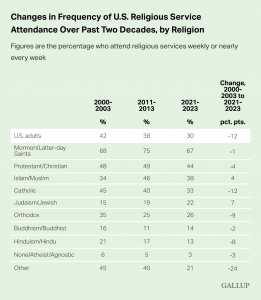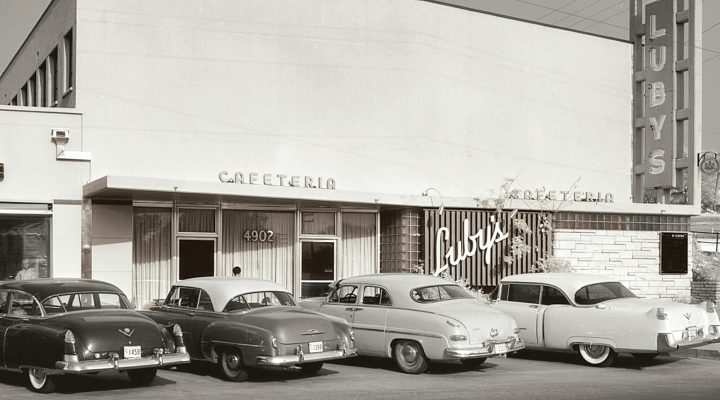The old joke about the Baptists trying to beat the Methodists to the cafeteria for Sunday lunch seems stale these days.
You might more easily find a remaining cafeteria in some towns than a plurality of people who actually attend church regularly.
And yet in Dallas, where I live, you can’t sit in any coffee shop on any day without overhearing a Bible study or an evangelism conversation. Yesterday afternoon at one of my favorite coffee spots, I watched two women talk about their faith journeys. That night, during an after-dinner stop at a trendy ice cream spot, one tattooed young man was clearly evangelizing two other young men.
I’ve had the same experience while visiting far-flung places outside the Bible Belt, too.
Perhaps religion has gone more meta these days, more coffee shop than corporate worship.

What we know from Gallup’s years of polling data is that only 21% of Americans today say they attend religious services every week and another 9% say they attend about every other week. That 30% of the population that could be classified as “regular attenders” is down from 42% just two decades ago.
Keep in mind that other previous research has shown Americans tend to inflate their church attendance habits when asked about it by pollsters. So all these numbers should be considered optimistic.
These days, even the term “regular attender” doesn’t mean what it used to mean. “Regular” in most churches these days means about two Sundays a month. These are the deacons, Sunday school teachers, choir members and ushers.
Six or seven years ago, while still the staff person at our church responsible for monitoring and interpreting attendance data, I documented a trend exactly like what Gallup has found. And as I’ve talked with other pastors, I’ve heard this confirmed over and over.
On a positive note from Gallup, members of the Church of Jesus Christ of Latter-day Saints are more than twice as likely as everyone else to attend church services regularly.
On the negative side, 56% of Americans seldom or never attend any church services. That is a much bigger problem for churches than the spotty attendance of their regulars.
And the attendance numbers are worse for younger adults. Gallup reports that “young adults, both those with and without a religious preference, are much less likely to attend religious services — 22% attend regularly, 8 points below the national average.”
An unspoken data point is that as more American adults stop attending religious services, their children are less exposed to religious teaching and worship. It only takes one generation to lose an entire family from church.
I encounter this nearly every week in serving families who need a funeral preacher. Very few of the deceased — who tend to be older — could be classified as “unchurched,” but instead most all are “dechurched.” The difference in terms is that the “unchurched” are those who never have been church attenders, compared to the “dechurched,” who have dropped out or slid away from regular church participation.
“Children of the dechurched quickly become unchurched.”
Children of the dechurched quickly become unchurched. Thus, the patterns of declining church attendance seen today will continue to multiply like a snowball down a hill. It is becoming exponentially more common for children to be raised in homes where they never or seldom attend church.
If this is all true, why are there so many more megachurches in America today, you might ask. The answer is simple, as we’ve previously reported: While the majority of churches in America are small, the majority of church attenders in America go to large churches.
According to the Hartford Institute for Religion Research: “The largest 9% of congregations contain about half of all churchgoers.”
And smaller churches in America are closing every day.
Take the Southern Baptist Convention, the nation’s largest Protestant denomination, as an example. Lifeway Research reports from 2022 data: “The primary reason congregations are no longer considered active Southern Baptist congregations is that they cease to exist. Around four in five of the missing congregations (79%) disbanded/closed, leaving Southern Baptists with 984 fewer congregations.”
Other Lifeway Research analysis found about 4,500 Protestant churches were closed in the U.S. in 2019 while only about 3,000 were started, leaving a net deficit of open churches.
That’s not too different than what has happened to cafeterias as well. As fewer people eat at cafeterias, more cafeterias close, meaning there are fewer cafeterias to attract customers. And the cycle continues.
And that’s a problem that affects both Baptists and Methodists alike, regardless of whose pastor preaches the shortest sermons.
Related articles:
Focus on the Family falsely says only liberal churches are declining | Analysis by Steve Rabey
Seven graphs that show the state of American religious attendance today


